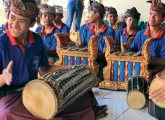Physical geography processes such as erosion and transportation can be difficult concepts for some students to comprehend. Traditionally, they are taught through learning key words and their definitions, and then drawing a diagram to represent each type of process. However, this approach does not always enable all students to understand the differences between them, and some learners can struggle to recall the information at a later date.
By using an unusual and/or fun activity to convey the relevant information, we can offer students a different and more engaging way of learning these concepts. We can also make them more memorable, as human beings have a tendency to hang on to a recollection of things that stand out from the norm or are funny.
WHY TEACH THIS?
The use of movement (or kinaesthetic learning) is a powerful way to develop students’ comprehension of key words and concepts in geography. The aim is to enhance learners’ understanding of geographical processes by acting them out, and to engage young people with these topics more generally. I first developed this learning activity in 2006 with a lower ability GCSE geography class, inspired by ‘Punctuation Kung Fu’ that was demonstrated by Phil Beadle, an English teacher, on the Channel 4 TV programme ‘The Unteachables’.
MAIN ACTIVITIES
Coastal Erosion Kung Fu
The aim of this learning activity is for students to understand the four different methods of how the sea can erode the land. The students will need to be able to explain what is meant by ‘erosion’ and ‘coast’ beforehand. You may want to start with an image of a stack and some arches, and ask the students to speculate how they were formed as a starter activity. Coastal Erosion Kung Fu is used to physically demonstrate the four methods of coastal erosion. You will need to display the four methods, with their geographical definitions. Then ask your students to stand up (I also opt for them to put their ties around their heads for extra effect), and teach them the moves, which are as laid out in the table, below.
Kung Fu style sound effects as you act these out are entirely optional, but do add to the atmosphere!
As a plenary to this learning activity, you can use questioning to see if the students understand the different methods. You can ask what the different body parts or movement represent; or enquire as to what the different coastal erosion methods are and allow them to use the movements as an aide-memoire.
Coastal Erosion
Hydraulic Action
Definition
This is the force of water hitting the cliff and squeezing air into the cracks in the rock.
Kung Fu Move
Make punching movements with hands. This demonstrates the force of the sea hitting the cliffs.
Coastal Erosion
Abrasion
Definition
This is the force of the bits of rock carried in the water blasting into the cliff.
Kung Fu Move
Make a throwing gesture with hands like you are throwing dealing cards (or shurikens) very rapidly. The weapons represent the rocks striking the cliffs.
Coastal Erosion
Attrition
Definition
This is the process of rocks hitting each other and breaking into smaller rocks.
Kung Fu Move
Make two fists, and then bring them towards each other, hitting each other. Then open your hands to resemble the stones breaking.
Coastal Erosion
Corrosion
Definition
This is a chemical reaction between the sea water and the minerals in the rocks which are dissolved.
Kung Fu Move
Have arms out stretched in front of you, waving your fingers, and moving arms downwards. Sound effect of something dissolving is needed.
River Dance
River Dance was inspired by Coastal Erosion Kung Fu. Instead of erosion, the focus is now on transportation within rivers. In terms of prior understanding, the students will need to understand what is meant by ‘transportation’ and ‘load’, in the context of physical geography. As with the previous example, you may want to have a way to display the different means by which a river transports its load with their geographical definitions.
Once again the relevant moves are shown in the table, below. As a plenary, you may want to call out the key words and get the students to act them out, and then explain what is happening to the river’s load. Or you could act out the process, and get the students to explain and name the process.
Transportation
Traction
Definition
Large rocks and boulders are rolled along the river bed.
Movement
Make a rolling motion with your forearms, one after the other.
Transportation
Saltation
Definition
Smaller stones and pebbles bounce along the river bed.
Movement
Make a short hopping motion on the spot.
Transportation
Suspension
Definition
Sediments and silt are carried within the main flow of the river.
Movement
Act as though you are floating inouter space.
Transportation
Solution
Definition
Dissolved material is carried inthe water.
Movement
Hide your head in the cradle of your armsor under a blazer, so you are ‘invisible.’
ADDITIONAL RESOURCES
• A powerpoint presentation or a work sheet that outlines each process, and may give details for the kung fu and river dance moves. an online search for ‘coastal erosion kung fu’ will produce a variety of results containing pre-made presentations.
• Backing music is always a fun option – and kung fu fighting by carl douglas is an obvious choice!
STRETCH THEM FURTHER
More able students can be encouraged either to develop alternative moves to represent the different forms of erosion and/or transportation, or to create moves for different physical geography processes. the idea is that students have to consider an alternative means to show how a process happens, therefore enhancing their understanding.
SUMMARY
These methods can be used with your students in the future as an aide-memoire or for revision purposes. If a student is struggling to remember what attrition is, for example, you can see if he or she can remember the action for it, or you can provide the action. Further scaffolding can be provided by pointing out that the fists represent rocks, and asking the student what is happening during the action. In terms of revision, you can see if the students can remember what the key word is from the actions, or if they can remember the actions from the key words.
ABOUT OUR EXPERT
Terry Portch is head of geography at All Saints Catholic School in Dagenham.









